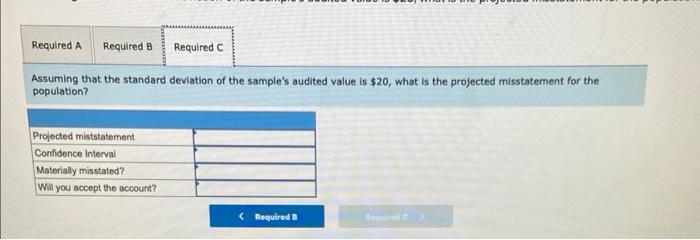You are the auditor of Jexel, an auto air-conditioner service and repair company, and you have decided to use the mean-per-unit method to test the existence and gross valuation of recorded accounts receivable. The client's records include 9,600 accounts with a total book value of $1,290,000. You decide to use tolerable misstatement of $177,000, an incorrect acceptance risk of 10 percent, and an incorrect rejection risk of 5.0 percent. Using Excel, you estimated the standard deviation of the population as $30. Use Figure 9-8 to obtain the incorrect acceptance and rejection coefficients. Required: a. Determine the sample size. b. Assume you tested the sample and got the following results: The mean audited value of the accounts sampled was $134. Assuming that the standard deviation of the sample's audited value is also $30, what is the projected misstatement for the population? c. Assuming that the standard deviation of the sample's audited value is $25, what is the projected misstatement for the population? Determine the sample size. (Roundup to the next whole number.) You are the auditor of Jexel, an auto air-conditioner service and repair company, and you have decided to use the mean-per-unit method to test the existence and gross valuation of recorded accounts receivable. The client's records include 9,600 accounts with a total book value of $1,290,000. You decide to use tolerable misstatement of $177,000, an incorrect acceptance risk of 10 percent, and an incorrect rejection risk of 5.0 percent. Using Excel, you estimated the standard deviation of the population as $30. Use Figure 98 to obtain the incorrect acceptance and rejection coefficients. Required: a. Determine the sample size. b. Assume you tested the sample and got the following results: The mean audited value of the accounts sampled was $134. Assuming that the standard deviation of the sample's audited value is also $30, what is the projected misstatement for the population? c. Assuming that the standard deviation of the sample's audited value is $25, what is the projected misstatement for the population? Assume you tested the sample and got the following results: The mean audited value of I Assuming that the standard deviation of the sample's audited value is also $25, what is t population? What is the confidence interval? Is the account materially misstated? Assuming that the standard deviation of the sample's audited value is $20, what is the projected misstatement for the population? You are the auditor of Jexel, an auto air-conditioner service and repair company, and you have decided to use the mean-per-unit method to test the existence and gross valuation of recorded accounts receivable. The client's records include 9,600 accounts with a total book value of $1,290,000. You decide to use tolerable misstatement of $177,000, an incorrect acceptance risk of 10 percent, and an incorrect rejection risk of 5.0 percent. Using Excel, you estimated the standard deviation of the population as $30. Use Figure 9-8 to obtain the incorrect acceptance and rejection coefficients. Required: a. Determine the sample size. b. Assume you tested the sample and got the following results: The mean audited value of the accounts sampled was $134. Assuming that the standard deviation of the sample's audited value is also $30, what is the projected misstatement for the population? c. Assuming that the standard deviation of the sample's audited value is $25, what is the projected misstatement for the population? Determine the sample size. (Roundup to the next whole number.) You are the auditor of Jexel, an auto air-conditioner service and repair company, and you have decided to use the mean-per-unit method to test the existence and gross valuation of recorded accounts receivable. The client's records include 9,600 accounts with a total book value of $1,290,000. You decide to use tolerable misstatement of $177,000, an incorrect acceptance risk of 10 percent, and an incorrect rejection risk of 5.0 percent. Using Excel, you estimated the standard deviation of the population as $30. Use Figure 98 to obtain the incorrect acceptance and rejection coefficients. Required: a. Determine the sample size. b. Assume you tested the sample and got the following results: The mean audited value of the accounts sampled was $134. Assuming that the standard deviation of the sample's audited value is also $30, what is the projected misstatement for the population? c. Assuming that the standard deviation of the sample's audited value is $25, what is the projected misstatement for the population? Assume you tested the sample and got the following results: The mean audited value of I Assuming that the standard deviation of the sample's audited value is also $25, what is t population? What is the confidence interval? Is the account materially misstated? Assuming that the standard deviation of the sample's audited value is $20, what is the projected misstatement for the population









